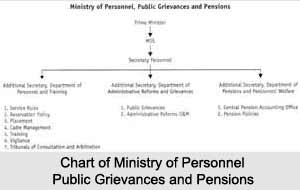 The Ministry of Personnel, Public Grievances and Pensions is a relatively new Ministry formed in March 1985. It was formed after the halving of two important functions of the Home Ministry, namely Public Services and Administrative Reforms. One of the important functions of the Home Ministry has always been the responsibility for general administration and in particular the organization and functioning of the services. This position continued till the transfer of its personnel functions to the newly created Department of Personnel in 1970 which was first located in the Cabinet Secretariat. This limited the jurisdiction of the Ministry in this sphere to administering the Indian Police Service cadres only.
The Ministry of Personnel, Public Grievances and Pensions is a relatively new Ministry formed in March 1985. It was formed after the halving of two important functions of the Home Ministry, namely Public Services and Administrative Reforms. One of the important functions of the Home Ministry has always been the responsibility for general administration and in particular the organization and functioning of the services. This position continued till the transfer of its personnel functions to the newly created Department of Personnel in 1970 which was first located in the Cabinet Secretariat. This limited the jurisdiction of the Ministry in this sphere to administering the Indian Police Service cadres only.
Though the Janata Government had the department shifted back to the Home Ministry in 1977, it was separated once and for all in 1985 and became a separate department. In the same year, the work of administrative reforms was transferred to the newly created Ministry of Personnel and became under it the Department of Administrative Reforms and Public Grievances. The Ministry of Personnel, Public Grievances and Pensions comprised the following three departments: Department of Personnel and Training, Department of Administrative Reforms and Public Grievances and Department of Pensions and Pensioner`s Welfare.
The Ministry of Personnel, Public Grievances and Pensions is now the coordinating agency of the Central Government in personnel matters specially issues concerning recruitment, training, career development, staff welfare as well as the post retirement dispensation. The Ministry is also concerned with the process of responsive people-oriented modern administration. Allocation of Business Rules defines the work allotted for the Ministry.
Organization of Ministry of Personnel, Public Grievances and Pensions
There is no separate Cabinet Minister in charge of the department. The Indian Prime Minister himself is the minister in overall charge of the ministry, who is assisted by a Minister of State and a Deputy Minister. In practice it is the Minister of State who looks after the Ministry`s functions. The Administrative head of the Ministry is Secretary (Personnel), who is assisted by three Additional Secretaries. These officers are in charge of the administration of each of the three departments in which the Ministry is divided. These officers have under them a number of Joint Secretaries who number seven. There is the usual supporting staff under them. The Ministry is staffed like any other Ministry and follows the well known tenure system. The Secretary is a senior officer in the cadre of the Indian Administrative Services and most of the senior policy-making posts are filled by the members of that service. However, the junior and middle level posts are occupied by the members of various allied service. In brief, it should be noted that there obtains no expertise or specialised knowledge of personnel matters among the staff.
Thus, given above is a brief outline of the formation and structuring of the Ministry of Personnel, Public Grievances and Pensions.




















